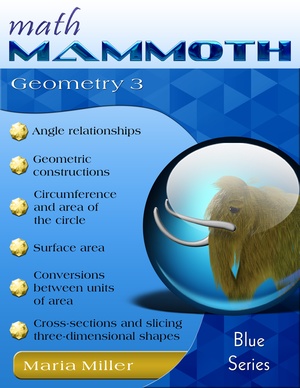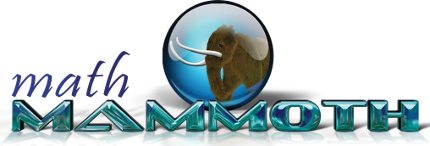Math Mammoth Geometry 3

107 pages
(includes answers)
Sample pages (PDF)
Contents
Angle Relationships
Basic Geometric constructions
Area of a Circle
Prices & ordering
PDF download USD $6.30
You will be purchasing the downloads from my authorized reseller Comecero.
Printed copy $11.45
Math Mammoth Geometry 3 covers geometry topics for 7th grade level. The main topics students encounter are:
- basic angle relationships
- drawing geometric figures, including basic geometric constructions
- pi and the area of a circle
- slicing 3-dimensional solids
- surface area and volume.
In the first lesson of the book, we examine various basic angle relationships: angles that are formed when several rays originate from the same starting point, vertical angles (formed when two lines intersect), and corresponding angles (formed when a line intersects two parallel lines).
Next, students practice drawing geometric figures. Basic geometric constructions are done just like in ancient times: with only a compass and straightedge (a ruler without measurement units). These constructions help students to think about the main defining features of a figure. Personally I have always enjoyed geometric constructions because they are like little puzzles to solve.
Students also draw figures using a normal ruler and compass in the lesson Drawing Problems. They especially determine whether the given information defines a unique figure (triangle or a parallelogram).
Then we turn our attention to pi. Students first learn the definition of pi as a ratio of a circle’s circumference to its diameter in the lesson Circumference of a Circle. Then they learn and practice how to calculate the area of a circle in a wide variety of word problems and applications. We also briefly study the proof for the formula for the area of a circle. I feel it is important that students encounter justifications for mathematical formulas and procedures and even read some proofs before high school. We don’t want students to think that mathematics is only a bag of magic tricks or formulas to memorize that seemingly came out of nowhere. Proofs and logical thinking are foundations to mathematics and school mathematics should not be left without them.
After this, we slice three-dimensional solids with a plane, and learn that the result (the cross-section) is always a two-dimensional shape. Students see that in a concrete way by slicing cubes and pyramids made of modeling clay. Some Internet links (provided in the lesson) will also help students to visualize what happens when a solid is cut with a plane.
In this book, students also solve a variety of problems concerning surface area and volume and practice converting between various units of area and volume. While these topics tend to involve lots of calculations and less possibilities for hands-on activities, they are very important in real life.
The PDF version of this book can be filled in on a computer, phone, or tablet, using the annotation tools found in many PDF apps. See more.
Note: The contents of this book were updated in February 2022, necessitated by the publishing of Math Mammoth Geometry 4 and the changes in Math Mammoth Geometry 2.
Better Yet - Bundle Deals!
Blue Series - $165 (download)Blue Series for grades 1-3 - $49 (download)
Blue Series for grades 4-5 - $47 (download)
Blue Series for grades 6-8 - $69 (download)
Light Blue Series, grades 1-8 - $225 (download)
Light Blue Series, grades 1-4 - $112.50 (download)
Light Blue Series, grades 5-8 - $112.50 (download)
All Inclusive Bundle - $275 (download)
"Everything" Bundle - $330 (download)
Learn more about the bundles!
*BONUS*: Buy any bundle listed above, and get the fully upgraded Soft-Pak software for FREE (includes 4 math and 2 language arts programs, complete with on screen and printable options).
How and where to order
You can buy Math Mammoth books at:
- Here at MathMammoth.com website — simply use the "Add to cart" buttons you see on the product pages.
- Rainbow Resource carries printed copies for the Light Blue series books, plus several CDs (Light Blue and Blue series).
- Homeschool Buyers Club offers download versions of the Light Blue series, plus the Blue series bundle.
- Homeschool Planet sells the digital versions of the main curriculum and lesson plans to go with them.
- K5 Learning offers download versions of the Blue series.
- TPT sells the Light Blue Series downloads, plus topical units.
- Lulu sells printed copies for most of the Math Mammoth materials (various series).
By purchasing any of the books, permission IS granted for the teacher (or parent) to reproduce this material to be used with his/her students in a teaching situation; not for commercial resale. However, you are not permitted to share the material with another teacher.
In other words, you are permitted to make copies for the students/children you are teaching, but not for other teachers' usage.
Math Mammoth books are PDF files. I recommend you use Adobe Reader to view them, including if you use a Mac. You can try other PDF viewers, but they may at times either omit or mess up some of the images.
Receive my monthly collection of math tips & resources directly in your inbox — and get a FREE Math Mammoth book!
You can unsubscribe at any time.
Math Mammoth TourConfused about the different options? Take a virtual email tour around Math Mammoth! You'll receive: An initial email to download your GIFT of over 400 free worksheets and sample pages from my books. Six other "TOURSTOP" emails that explain the important things and commonly asked questions concerning Math Mammoth curriculum. (Find out the differences between all these different-colored series!)This way, you'll have time to digest the information over one or two weeks, plus an opportunity to ask me personally about the curriculum. A monthly collection of math teaching tips & Math Mammoth updates (unsubscribe any time) We respect your email privacy.
Note: You will FIRST get an email that asks you to confirm your email address. If you cannot find this confirmation email, please check your SPAM/JUNK folder. |
"Mini" Math Teaching CourseThis is a little "virtual" 2-week course, where you will receive emails on important topics on teaching math, including:
- How to help a student who is behind You will also receive: A GIFT of over 400 free worksheets and sample pages from my books right in the very beginning.We respect your email privacy.
Note: You will FIRST get an email that asks you to confirm your email address. If you cannot find this confirmation email, please check your SPAM/JUNK folder. |
Maria's Math TipsEnter your email to receive math teaching tips, resources, Math Mammoth news & sales, humor, and more! I tend to send out these tips about once monthly, near the beginning of the month, but occasionally you may hear from me twice per month (and sometimes less often). Peek at the previous tips here. You will also receive:
We respect your email privacy.
|
|
